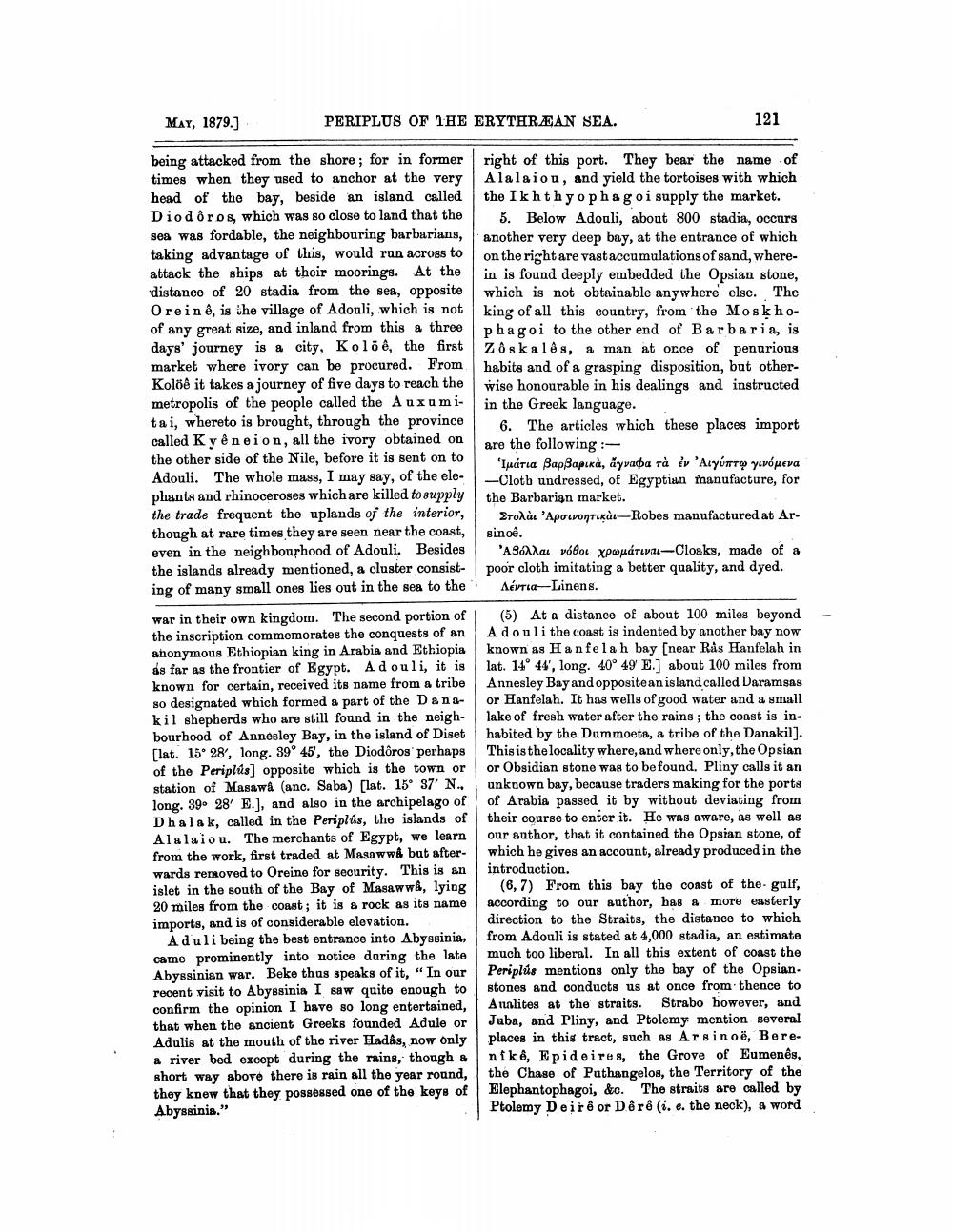________________
PERIPLUS OF THE ERYTHREAN SEA.
MAY, 1879.]
being attacked from the shore; for in former times when they used to anchor at the very head of the bay, beside an island called Diodoros, which was so close to land that the sea was fordable, the neighbouring barbarians, taking advantage of this, would run across to attack the ships at their moorings. At the distance of 20 stadia from the sea, opposite Oreinê, is the village of Adouli, which is not of any great size, and inland from this a three days' journey is a city, Kolöê, the first market where ivory can be procured. From Kolöê it takes a journey of five days to reach the metropolis of the people called the Auxumitai, whereto is brought, through the province called Kyê neion, all the ivory obtained on the other side of the Nile, before it is sent on to Adouli. The whole mass, I may say, of the elephants and rhinoceroses which are killed to supply the trade frequent the uplands of the interior, though at rare times they are seen near the coast, even in the neighbourhood of Adouli. Besides the islands already mentioned, a cluster consisting of many small ones lies out in the sea to the
war in their own kingdom. The second portion of the inscription commemorates the conquests of an anonymous Ethiopian king in Arabia and Ethiopia ás far as the frontier of Egypt. Adouli, it is known for certain, received its name from a tribe so designated which formed a part of the Danakil shepherds who are still found in the neighbourhood of Annesley Bay, in the island of Diset [lat. 15° 28', long. 39° 45', the Diodôros perhaps of the Periplus] opposite which is the town or station of Masawa (anc. Saba) [lat. 15° 37' N.. long. 39° 28' E.], and also in the archipelago of Dhalak, called in the Periplus, the islands of Alalaiou. The merchants of Egypt, we learn from the work, first traded at Masawwå but afterwards removed to Oreine for security. This is an islet in the south of the Bay of Masawwâ, lying 20 miles from the coast; it is a rock as its name imports, and is of considerable elevation.
Aduli being the best entrance into Abyssinia, came prominently into notice during the late Abyssinian war. Beke thus speaks of it, "In our recent visit to Abyssinia I saw quite enough to confirm the opinion I have so long entertained, that when the ancient Greeks founded Adule or Adulis at the mouth of the river Hadâs, now only a river bed except during the rains, though a short way above there is rain all the year round, they knew that they possessed one of the keys of Abyssinia."
121
right of this port. They bear the name of Alalaion, and yield the tortoises with which the Ikhthyophagoi supply the market.
5. Below Adouli, about 800 stadia, occurs another very deep bay, at the entrance of which on the right are vast accumulations of sand, wherein is found deeply embedded the Opsian stone, which is not obtainable anywhere else. The king of all this country, from the Moskhophagoi to the other end of Barbaria, is Zôskalês, a man at once of penurious habits and of a grasping disposition, but otherwise honourable in his dealings and instructed in the Greek language.
6. The articles which these places import are the following:
Ιμάτια βαρβαρικὰ, ἄγναφα τὰ ἐν ̓Αιγύπτῳ γινόμενα -Cloth undressed, of Egyptian manufacture, for the Barbarian market.
Στολὰι ̓Αρσινοητικὰι—Robes manufactured at Ar
sino.
̓Αβόλλαι νόθοι χρωμάτινπι--Cloaks, made of a poor cloth imitating a better quality, and dyed. Aévria-Linens.
(5) At a distance of about 100 miles beyond A douli the coast is indented by another bay now known as Hanfelah bay [near Rås Hanfelah in lat. 14° 44', long. 40° 49′ E.] about 100 miles from Annesley Bay and opposite an island called Daramsas or Hanfelah. It has wells of good water and a small lake of fresh water after the rains; the coast is inhabited by the Dummoeta, a tribe of the Danakil]. This is the locality where, and where only, the Opsian or Obsidian stone was to be found. Pliny calls it an unknown bay, because traders making for the ports of Arabia passed it by without deviating from their course to enter it. He was aware, as well as our author, that it contained the Opsian stone, of which he gives an account, already produced in the introduction.
(6, 7) From this bay the coast of the gulf, according to our author, has a more easterly direction to the Straits, the distance to which from Adouli is stated at 4,000 stadia, an estimate much too liberal. In all this extent of coast the Periplús mentions only the bay of the Opsian. stones and conducts us at once from thence to Aualites at the straits. Strabo however, and Juba, and Pliny, and Ptolemy mention several places in this tract, such as Arsinoë, Berenikê, Epideires, the Grove of Eumenês, the Chase of Puthangelos, the Territory of the Elephantophagoi, &c. The straits are called by Ptolemy Deirê or Dêrê (i. e. the neck), a word




